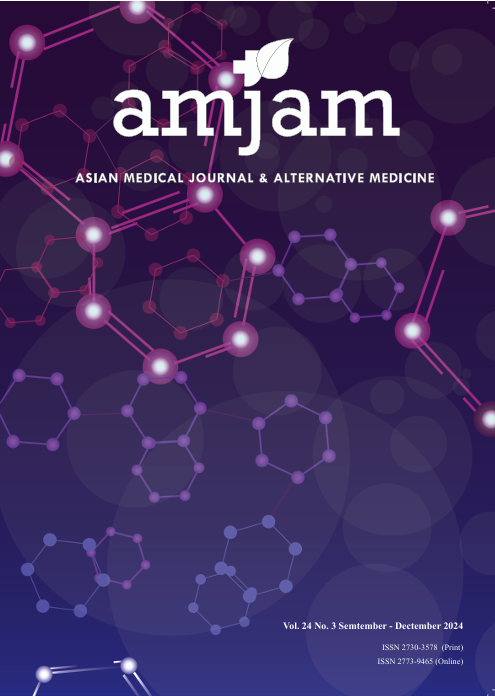Effect of Benzalkonium Chloride and Chlorhexidine on the Antibiotic Susceptibility of Pseudomonas aeruginosa
Biocide Effect on P. aeruginosa Susceptibility
Keywords:
Pseudomonas aeruginosa, Benzalkonium chloride, Chlorhexidine, Biocides, Antibiotic resistanceAbstract
Introduction: The transmission of Pseudomonas aeruginosa can be controlled using biocides such as benzalkonium chloride (BKC) and chlorhexidine (CHX). However, debates continue over whether biocide exposure contributes to the development of antibiotic resistance.
Objectives: To investigate the impact of BKC and CHX exposure on the development of antibiotic resistance in P. aeruginosa.
Methods: The minimal inhibitory concentrations (MICs) of P. aeruginosa PAO1 (ATCC27853) and 15 clinical isolates against BKC and CHX were determined. The bacteria were grown in media containing subinhibitory concentrations (SICs) of these biocides for five consecutive passages. MICs for ciprofloxacin, ceftazidime, and gentamicin, as well as their susceptibility status, were compared before and after exposure.
Results: The MIC of BKC ranged from 0.002% to 0.047%, while the MIC of CHX was 0.001%, both well below their recommended concentrations. After exposure to BKC and CHX, most strains showed minimal or no changes in MIC values for ciprofloxacin, ceftazidime, and gentamicin, with no significant changes in antibiotic susceptibility. A few strains, such as SP275, P330, SP119, SP546, and SP48, exhibited more than twofold MIC increases, but these changes were not statistically significant. After CHX exposure, strain P10 showed significant MIC changes without altering its susceptibility status to ciprofloxacin or ceftazidime.
Conclusion: Exposure to SICs of BKC and CHX increased antibiotic MICs in a minority of P. aeruginosa strains without affecting their antibiotic susceptibility status. This research provides valuable data supporting the use of biocides in infection control in both healthcare settings and the general environment.
Downloads
References
Klevens RM, Edwards JR, Richards CL, et al. Estimating health care-associated infections and deaths in U.S. hospitals, 2002. Public Health Rep. 2007;122(2):160-166.
Agyeman WY, Bisht A, Gopinath A, et al. A systematic review of antibiotic resistance trends and treatment options for hospital-acquired multidrug-resistant infections. Cureus. 2022;14(10):e29956.
Al-Hiyasat AS, Ma’ayeh SY, Hindiyeh MY, Khader YS. The presence of Pseudomonas aeruginosa in the dental unit waterline systems of teaching clinics. Int J Dent Hyg. 2007;5(1):36-44.
Wisplinghoff H, Bischoff T, Tallent SM, Seifert H, Wenzel RP, Edmond MB. Nosocomial bloodstream infections in US hospitals: analysis of 24,179 cases from a prospective nationwide surveillance study. Clin Infect Dis. 2004;39(3):309-317.
Pang Z, Raudonis R, Glick BR, Lin T-J, Cheng Z. Antibiotic resistance in Pseudomonas aeruginosa: mechanisms and alternative therapeutic strategies. Biotechnol Adv. 2019;37(1):177-192.
World Health Organization. Prioritization of pathogens to guide discovery, research and development of new antibiotics for drug resistant bacterial infections, including tuberculosis. 2017. Available from: https://iris.who.int/handle/10665/311820.
Jarvis WR. Infection control and changing health-care delivery systems. Emerg Infect Dis. 2001;7(2):170-173.
Russell AD. Introduction of biocides into clinical practice and the impact on antibiotic-resistant bacteria. J Appl Microbiol. 2002;92(Suppl):121s-135s.
Meyer B, Cookson B. Does microbial resistance or adaptation to biocides create a hazard in infection prevention and control? J Hosp Infect. 2010;76(3):200-205.
Reitzel RA, Rosenblatt J, Gerges BZ, Jarjour A, Fernández-Cruz A, Raad, II. The potential for developing new antimicrobial resistance from the use of medical devices containing chlorhexidine, minocycline, rifampicin and their combinations: a systematic review. J Antimicrob Chemother. 2020;2(1):dlaa002.
CLSI. Performance standards for antimicrobial susceptibility testing, 32nd ed. CLSI Supplement M100. Clinical and Laboratory Standards Institute. 2022.
Elfadadny A, Ragab RF, AlHarbi M, et al. Antimicrobial resistance of Pseudomonas aeruginosa: navigating clinical impacts, current resistance trends, and innovations in breaking therapies. Front. Microbiol. 2024;15:1374466.
Jones IA, Joshi LT. Biocide use in the antimicrobial era: a review. Molecules. 2021;26(8).
Kampf G. Biocidal agents used for disinfection can enhance antibiotic resistance in gram-negative species. Antibiotics. 2018;7(4).
Rozman U, Pušnik M, Kmetec S, Duh D, Šostar Turk S. Reduced susceptibility and increased resistance of bacteria against disinfectants: a systematic review. Microorganisms. 2021;9(12).
Basiry D, Entezari Heravi N, Uluseker C, Kaster KM, Kommedal R, Pala-Ozkok I. The effect of disinfectants and antiseptics on co- and cross-selection of resistance to antibiotics in aquatic environments and wastewater treatment plants. Front Microbiol. 2022;13.
Kim M, Weigand MR, Oh S, et al. Widely used benzalkonium chloride disinfectants can promote antibiotic resistance. Appl Environ Microbiol. 2018;84(17).
Merchel Piovesan Pereira B, Tagkopoulos I. Benzalkonium chlorides: uses, regulatory status, and microbial resistance. Appl Environ Microbiol. 2019;85(13).
Braoudaki M, Hilton AC. Adaptive resistance to biocides in Salmonella enterica and Escherichia coli O157 and cross-resistance to antimicrobial agents. J Clinic Microbiol. 2004;42(1):73-78.
Kawamura-Sato K, Wachino J, Kondo T, Ito H, Arakawa Y. Correlation between reduced susceptibility to disinfectants and multidrug resistance among clinical isolates of Acinetobacter species. J Antimicrob Chemother. 2010;65(9):1975-1983.
Loughlin MF, Jones MV, Lambert PA. Pseudomonas aeruginosa cells adapted to benzalkonium chloride show resistance to other membrane-active agents but not to clinically relevant antibiotics. J Antimicrob Chemother. 2002;49(4):631-639.
Russell AD. Biocide use and antibiotic resistance: the relevance of laboratory findings to clinical and environmental situations. Lancet Infect Dis. 2003;3(12):794-803.
Amsalu A, Sapula SA, Lopes MD, et al. Efflux pump-driven antibiotic and biocides cross-resistance in Pseudomonas aeruginosa isolated from different ecological niches: A case study in the development of multidrug resistance in environmental hotspots. Microorganisms. 2020;8:1647.
Thomas L, Russell AD, Maillard JY. Antimicrobial activity of chlorhexidine diacetate and benzalkonium chloride against Pseudomonas aeruginosa and its response to biocide residues. J Appl Microbiol. 2005;98(3):533-543.
Thomas L, Maillard JY, Lambert RJ, Russell AD. Development of resistance to chlorhexidine diacetate in Pseudomonas aeruginosa and the effect of a “residual” concentration. J Hosp Infect. 2000;46(4):297-303.
Cole EC, Addison RM, Rubino JR, et al. Investigation of antibiotic and antibacterial agent cross-resistance in target bacteria from homes of antibacterial product users and nonusers. J Appl Microbiol. 2003;95(4):664-676.
Downloads
Published
How to Cite
Issue
Section
License
Copyright (c) 2024 Asian Medical Journal and Alternative Medicine

This work is licensed under a Creative Commons Attribution-NonCommercial-NoDerivatives 4.0 International License.



